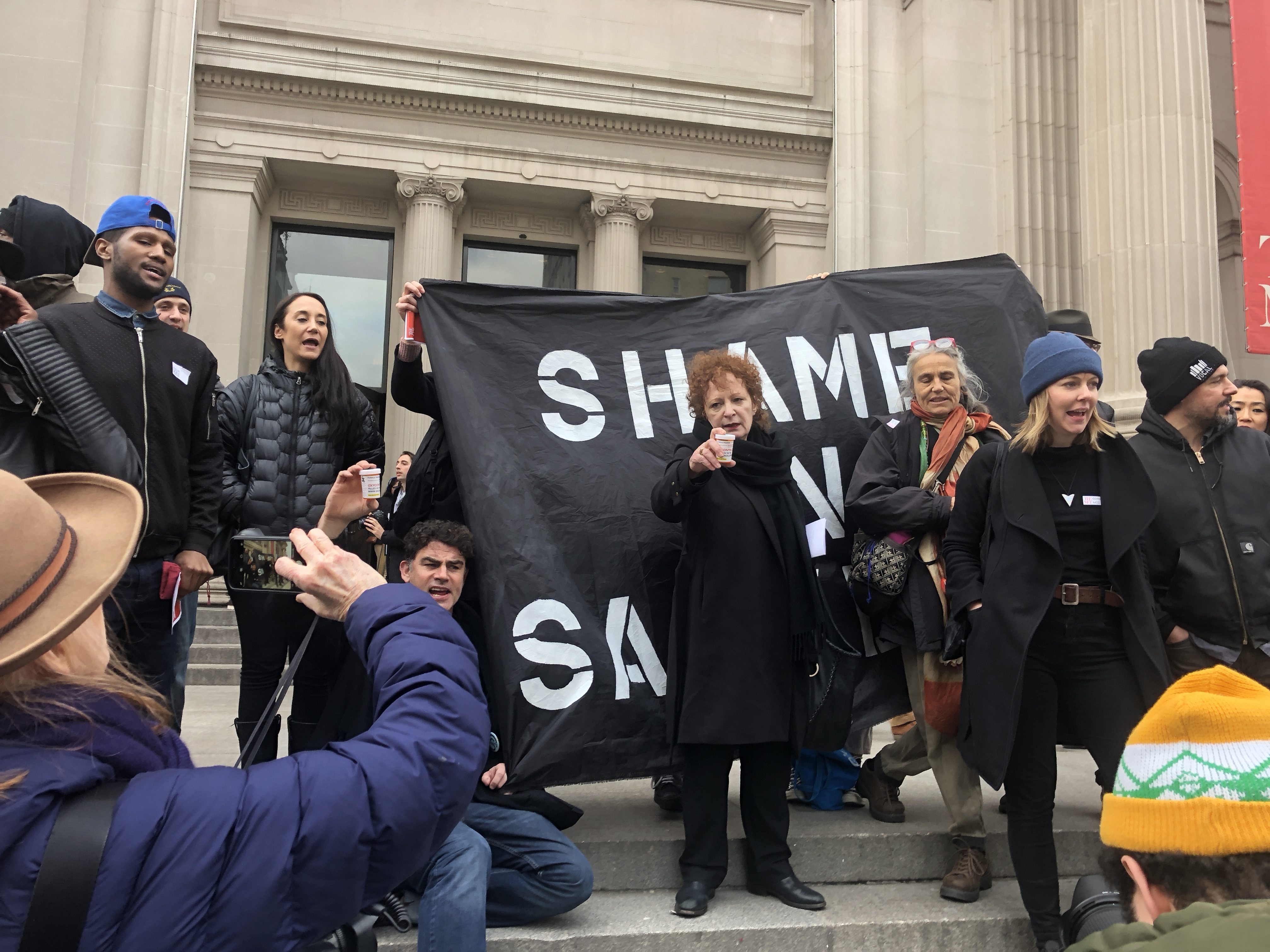[ad_1]
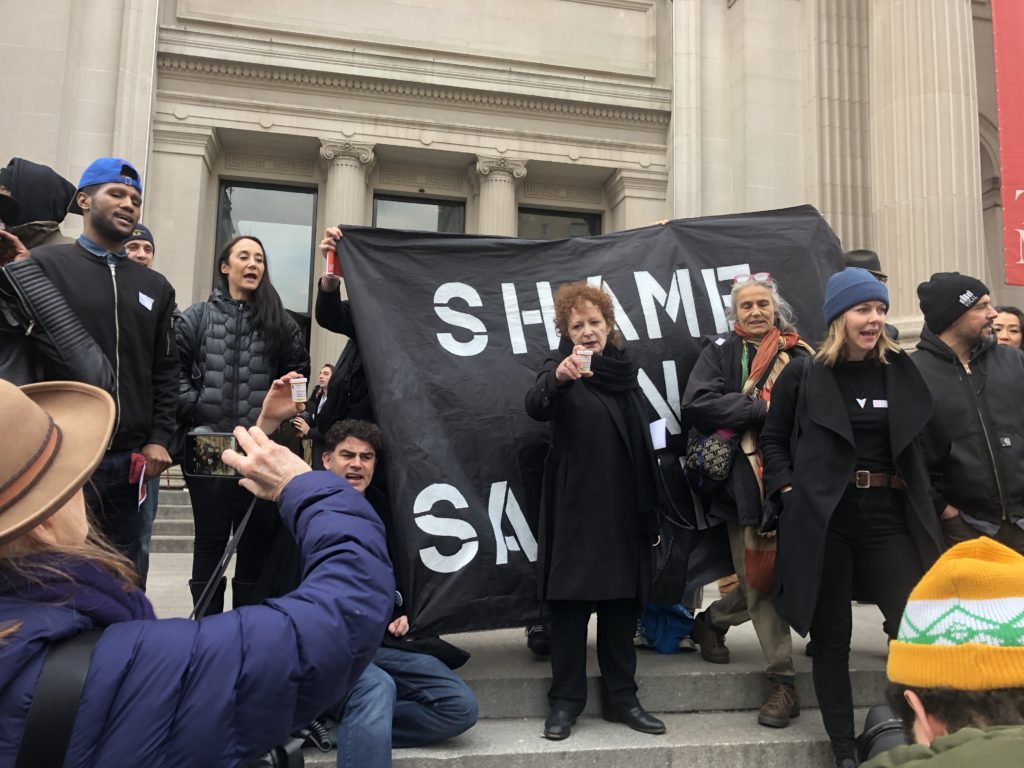
Nan Goldin (center) protesting with the activist group P.A.I.N. at the Metropolitan Museum of Art in New York on March 10, 2018.
ANDREW RUSSETH/ARTNEWS
In 2018, we witnessed all kinds of protests and petitions that called attention to abuses of power, inequity, and privilege in the cultural sector. Activism in the arts shows no signs of slowing down in the coming year, so we at ARTnews collected some of the year’s notable art-world disruptions. These events are listed chronologically below.
March 2: Artists circulate a petition calling for the Great Exhibition of the North to drop BAE Systems as a sponsor
Earlier this year, artists began pulling out of the Great Exhibition of the North, a two-month arts festival that opened in June in England, due to its partnership with BAE Systems, a major British arms dealer. Artists Emily Hesse and Jill Gibbon and curator Sara Makari-Aghdam created a petition called Art Not Arms, which demanded that leadership of the event reject sponsorship from BAE Systems. It read, in part: “British arms companies including BAE have made more than £6bn from sales to Saudi Arabia during the ongoing war in Yemen.” Some 600 individuals signed the petition, and, ultimately, BAE Systems withdrew its sponsorship. The company said in a statement that it would “redirect our support to other initiatives better suited to both our skills and innovation objectives.” In response, Art Not Arms tweeted, “We did it! BAE have pulled out of the exhibition. We can influence change when we stand united.”
March 10: Nan Goldin and P.A.I.N. protest Purdue Pharmaceuticals and the Sackler family at the Metropolitan Museum of Art
Around the same time as the BAE petition, photographer Nan Goldin led a demonstration against Purdue Pharmaceuticals, which is owned by some members of the Sackler family, for its alleged involvement in fueling the opioid crisis. The protest took place in New York at the Metropolitan Museum of Art’s Sackler Wing, which contains the famed Temple of Dendur. Goldin and her activist group P.A.I.N. threw pill bottles in the wing’s pool, and they also staged a die-in amid shouts of “Sacklers lie, people die.” (The group’s name is short for Prescription Addiction Intervention Now.) Pamphlets distributed at the protest called on the Sacklers “to donate their money to helping combat the opioid epidemic” rather than “continuing to wash their money in great institutions (like the Metropolitan Museum of Art).” Though the museum declined to comment, Jillian Sackler, the widow of Arthur M. Sackler, who helped fund the construction of the Sackler Wing, said through a spokesperson that he died before the sale of OxyCotin began and that his heirs have not benefited from it, adding, “Passing judgment on Arthur’s life’s work through the lens of the opioid crisis some 30 years after his death is a gross injustice.”
April 14: Independent Workers Union of Great Britain protests Tate Modern’s Ernst & Young sponsorship
The exhibition “Picasso 1932: Love, Fame, Tragedy” at Tate Modern in London became the subject of a protest by members of the Independent Workers Union of Great Britain after it came to light that the investment firm Ernst & Young had been one of its sponsors. Cleaning workers at Ernst & Young were facing potential layoffs, and one sign at the action read, “You say cut-back, we say fight back.” A press officer for IWGB said at the time that, through the demonstration, “We wanted to make people aware of how these low paid migrant workers are being treated. Cleaners provide such a vital service to our society, so we have to do what we can to ensure that their struggle is visible.”
April 26: Nan Goldin and P.A.I.N. demonstrate at Smithsonian Institution’s Arthur M. Sackler Gallery
On the heels of their protest at the Met, Goldin and P.A.I.N. traveled to the Arthur M. Sackler Gallery at the Smithsonian Institution in Washington, D.C. Protesters threw pill bottles into a fountain in the museum, and the photographer told her audience, “The Sackler brothers built an empire of pain on hundreds of thousands of people. For them, addiction equals profits.” She also referenced her own experience with addiction, saying, “I am speaking for those who can’t speak anymore. For me, the personal is now political.”

Decolonize This Place protesters at the Brooklyn Museum in New York on April 29, 2018.
MARAL BABAI
April 29: Decolonize This Place Calls for diversity at the Brooklyn Museum
In late March, the Brooklyn Museum in New York announced that it had hired Kristen Windmuller-Luna, a white woman, as a consulting curator for the African art department. This appointment spurred the activist group Decolonize This Place to write an open letter that urged the museum to take steps to diversify its curatorial staff, replace certain board members, and establish a “Decolonization Commission” that would help it focus on its “role in the histories of colonialism and white supremacy.” A protest at the museum by the group followed in late April. One speech included a hat tip to Helen Molesworth, who was fired from her position as the chief curator of the Museum of Contemporary Art, Los Angeles earlier in the year. In addition to speaking out against Windmuller-Luna’s appointment, protesters addressed issues related to gentrification. In a statement, the museum’s director, Anne Pasternak, said, “Please know that every day the Brooklyn Museum is working to advance these efforts and its longstanding and widely recognized commitment to equity in all its forms, including race, class, gender, and sexual orientation.”
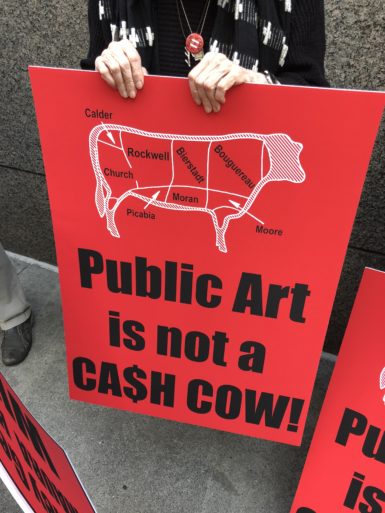
A sign held at a protest against the selling off of deaccessioned Berkshire Museum holdings outside Sotheby’s in New York on May 14, 2018.
ANDREW RUSSETH/ARTNEWS
May 14: Protesters oppose Sotheby’s sale of Berkshire Museum lots
A group of demonstrators wielded banners with messages like “public art is not a cash cow” during a Sotheby’s sale of Impressionist and modern art that included deaccessioned pieces from the Berkshire Museum in Pittsfield, Massachusetts. Among the works that sold from the two Berkshire lots were Henry Moore’s Three Seated Women (1942), which went for $300,000, and Francis Picabia’s Force Comique (1914), a work on paper that brought in $1.12 million.
May 31: MoMA union demonstrates outside summer gala
Amid negotiations with management over health care coverage and overtime, a union at the Museum of Modern Art in New York, Local 2110, put on what it called a “Party on the Pavement” outside the museum’s annual Party in the Garden gala. Union members marched and chanted “Get up, get down! New York is a union town!” as the glitzy affair carried on just a short distance away. A second demonstration was held in the museum’s lobby in August. MoMA workers reached an agreement with the museum that same month; their five-year contract with the museum includes a new structure for wage increases and amendments to the health care plan.
July 15: Pussy Riot leads a protest at the World Cup final
Four protesters charged into the middle of a soccer game at the World Cup final in Moscow, in hopes of calling attention to abuses of power by the government and police. In a video, the Russian art collective Pussy Riot claimed responsibility for the disruption, emphasizing the rampant unwarranted arrests taking place in the country. Four members of the group were sentenced to 15 days in jail as a result.
July 20: Nan Goldin and P.A.I.N. activists bring Sackler protest to Harvard Art Museums
Nan Goldin and P.A.I.N. took to another art institution bearing the Sackler name: the Arthur M. Sackler Museum in Cambridge, Massachusetts. According to a P.A.I.N. member, about 70 people—including medical students from Harvard University, NYU, and Boston University—participated in the action. As with previous iterations, the activists tossed pill bottles in the museum’s atrium. Though the Harvard Art Museums declined to comment on the protest, a representative for Purdue Pharmaceuticals said via email that the company has, through various initiatives, “led industry efforts to combat prescription drug abuse.”
July 27: ACT UP holds an intervention at the Whitney Museum’s David Wojnarowicz retrospective
The New York chapter of AIDS Coalition to Unleash Power—better known by its acronym ACT UP—protested the David Wojnarowicz retrospective at the Whitney Museum in New York, alleging that the show incorrectly framed the history of the AIDS epidemic and made it seem as if it were effectively finished. The group’s intervention involved some 12 group members who printed out recent articles related to HIV/AIDS, stood next to works in the show, and held the reports up to viewers. The Whitney’s statement responding to the action read, in part, “The more this vital subject can be brought front and center, the better. We completely agree that the AIDS crisis is not history.” Soon after ACT UP’s demonstration, the museum added new wall text to accompany Wojnarowicz’s 1990 screenprint Untitled (ACT UP) that details the late artist’s involvement in the group.
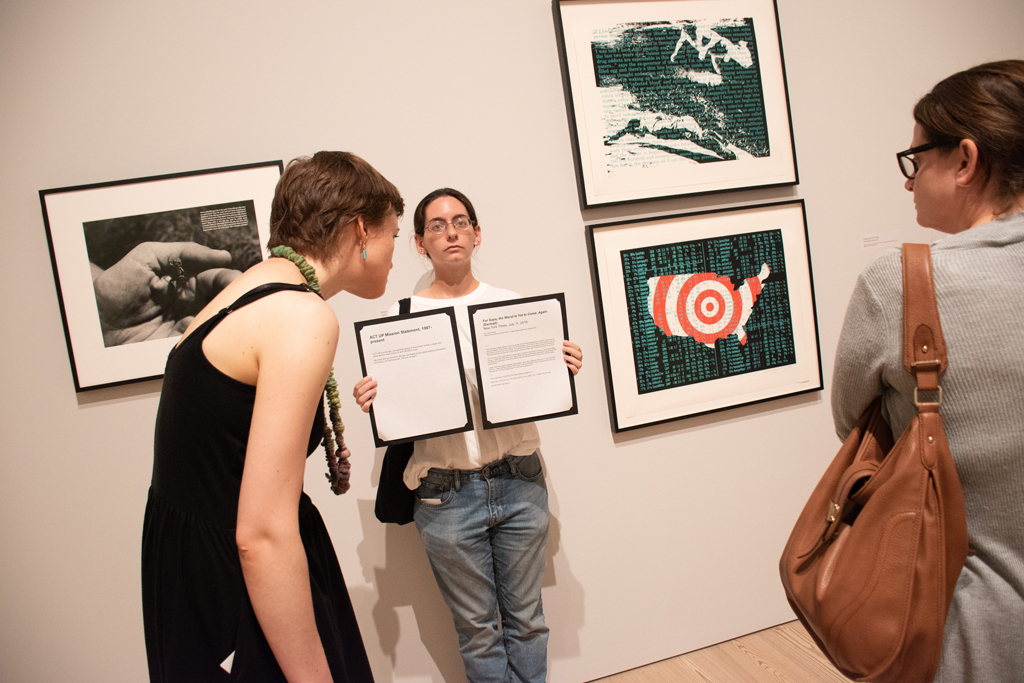
Members of ACT UP stage a protest at the Whitney Museum during its David Wojnarowicz exhibition on July 27, 2018.
MICHELLE WILD, SHUTTERBUGBOUDOIR.COM
August 5: The arrest of Bangladeshi photographer and activist Shahidul Alam triggers protests
Photographer Shahidul Alam was arrested by over 20 officers on August 5 at his home in Dhaka, Bangladesh, and was subsequently charged for his “provocative comments” regarding recent road safety demonstrations in which police used rubber bullets and tear gas against peaceful protesters. The Art Newspaper later reported that Alam was tortured in prison. In response, the Kochi Biennale Foundation and 473 Indian arts professionals publicly expressed support for Alam and denounced his arrest. Alam was released on bail in November. He was incarcerated for over 100 days in prison, and he still faces up to 14 years of incarceration, according to Time.
August 20: A Confederate monument is toppled at the University of North Carolina, Chapel Hill
At this event, students at the UNC in Chapel Hill wore bandanas bearing the message “Sam must fall,” in reference to Silent Sam, a bronze statue of a Confederate soldier that was covered in banners by protesters, removed, and destroyed. The day after the event, the university released a statement saying that “at no time did the administration direct the officers to allow protesters to topple the monument.” Some university officials—including chancellor Carol Folt—criticized the act. The New York Times reported that, following the toppling of Silent Sam, “people in Chapel Hill seemed generally pleased it was gone.” It remains undecided what will become of the statue and whether it will be displayed on the campus in the future.
September 3: A fire at the National Museum in Rio de Janeiro alarms the public
After a raging fire destroyed a large swath of the holdings of Brazil’s 200-year-old National Museum in Rio de Janeiro, various reports suggested that the federal spending cuts and insufficient maintenance of the museum’s building may have been connected to the severity of the blaze. When this news surfaced, hundreds of people gathered to voice their anger and dismay over the irreparable damage to the institution and the alleged negligence on the part of the government.
September 6: Students disrupt the opening of the Goldsmiths Centre for Contemporary Art in London
The press preview for the opening of Goldsmiths Centre for Contemporary Art at the University of London was interrupted by student activists who intended to bring attention to the employment and working conditions of the university’s outsourced janitorial staff. The protesters tooted horns and brought with them signs that read “Who keeps the cube white?” A spokesperson for Goldsmiths acknowledged the students’ “right to peaceful protest” and said that the institution was “involved in discussions with cleaners and their recognized trade union UNISON.”
September 16: An anti-gentrification protest is held outside Chimento Contemporary in Los Angeles
Some 20 activists congregated at Chimento Contemporary to protest gentrification in the West Adams neighborhood in South Central Los Angeles, and, as a result, the gallery took down one of two exhibitions on view at the time. One of the organizers, Paul Lanctot, told Hyperallergic by phone, “If artists want to be serious about supporting low-income folks and people of color then they should join the movement for rent control and housing rights for all.” Signs at the protest had messages like “STOP PUSHING OUT POC” and “FUCK YOUR ART,” and police later arrived in four squad cars and a helicopter. Dealer Eva Chimento said that she was being harassed and targeted by protesters, telling Hyperallergic, “I’ve had empty bullet casings left on my doorstep [of the gallery]. I’m pretty sure that someone has got it out for me specifically.”
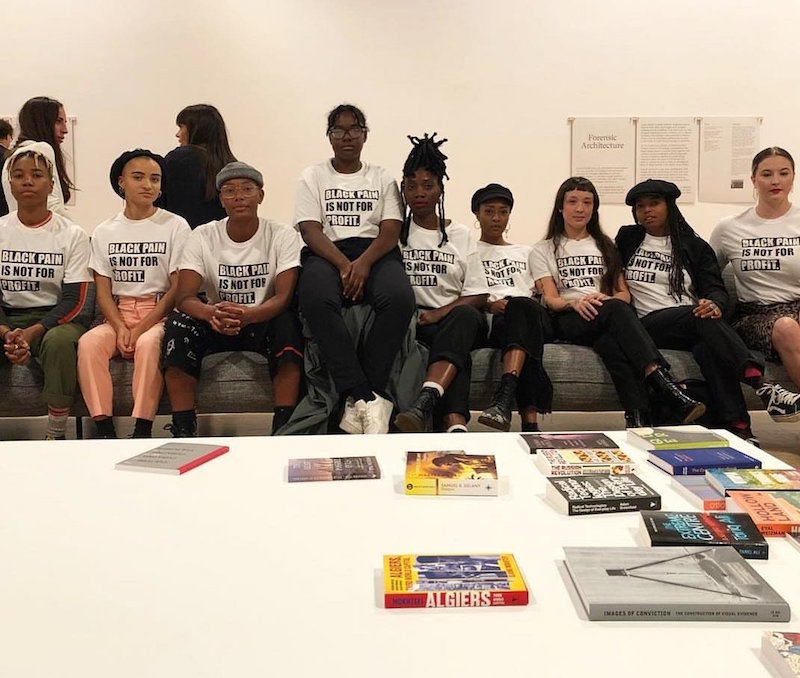
BBZ London at Tate Britain on September 25, 2018.
VIA INSTAGRAM
September 25: BBZ London leads a protest at Tate Britain after Luke Willis Thompson is nominated for the Turner Prize
Earlier this year, the artist Luke Willis Thompson received a Turner Prize nomination for his video piece Autoportrait (2017), which features close-up shots of Diamond Reynolds, the girlfriend of Philando Castile, who was shot by a police officer in Minnesota in 2016. (This year’s prize would ultimately be won by Charlotte Prodger.) Though widely praised by critics, some found the Thompson work to be exploitative, and the group BBZ London led a protest at the Turner Prize show at Tate Britain in London. Members of the group went to the museum wearing T-shirts that read “BLACK PAIN IS NOT FOR PROFIT” and posted a message on Instagram in which they explained their action: “BBZ London decided to take a symbolic stand at the Turner prize opening . . . against the utilization of Black Death and Black pain by non-black artists and arts institutions for cultural and financial gain.”
October 27: BP or Not BP? holds an action at the British Museum
In response to the exhibition “I object: Ian Hislop’s search for dissent” at the British Museum, which was sponsored by the oil behemoth BP, the activist group BP or Not BP? staged a protest at the London institution. Organizers came with props and pamphlets that outlined their grievances. Hyperallergic reported that “it took over an hour for exhibition staff to realize that the protesters weren’t actually a part of the exhibition.” In a statement given to Hyperallergic, a British Museum spokesperson said, “The long-term support provided by BP allows the Museum to plan its programming in advance and to bring world cultures to a global audience through hugely popular exhibitions and their associated public programmes.”
November 3: Michelle Hartney creates an artwork that decries the Met’s wall labels performance
For a piece titled Performance/Call to Action, artist and activist Michelle Hartney put up additional wall labels near artworks by Paul Gauguin and Pablo Picasso at the Met. Hartney’s descriptions of the works highlight unsavory aspects of the artists’ biographies, in particular the artists’ mistreatment of women. Hartney’s new labels were removed once museum staff noticed them.

Members of the union Local 30 protesting wage rates outside MoMA PS1 in New York on November 18, 2018.
ALEX GREENBERGER/ARTNEWS
November 18: A MoMA PS1 installers union demands better wages
Workers from the MoMA PS1 installers and maintenance workers union Local 30 came together on a Sunday afternoon to raise awareness for their ongoing negotiations with museum management over pay rates. The action featured a giant inflatable rat, and flyers distributed by protesters included a phone number for the institution’s chief operating officer Jose Ortiz. In a statement issued prior to the protest, the museum called their talks with union members “a productive process” and said that it was “confident” that the two parties would reach an “amicable resolution.”
November 30: Protesters call for restitution of Benin bronze at RISD
Students and faculty at Brown University and the Rhode Island School of Design, along with members of the local community, assembled at the entrance to the RISD Museum in Providence to demand the restitution of the museum’s Benin bronze to Nigeria. Protesters handed out posters with the message: “Heads Up RISD. Decolonization, or Complicity? RISD, you have a decision to make.” The museum said in a statement to Hyperallergic that it had initiated talks with Oba Ewuare II and the National Commission for Museums and Monuments in Nigeria to return the work.
November 30: Decolonize This Place demands repatriation of cultural objects at the Brooklyn Museum
The same day that protesters took to the RISD Museum, Decolonize This Place took to the Brooklyn Museum once more. The group demanded that works they argue were improperly taken as a result of colonialism be repatriated to their countries of origin. As with its April protest at the institution, Decolonize This Place also called on the museum to create a “Decolonization Commission.” The action took place in the museum’s “Soul of a Nation: Art in the Age of Black Power” exhibition, where protesters held up a banner with that read, “Reparations/Repatriation NOW!”
December 3: Tania Bruguera is arrested in Cuba for protesting a censorship decree
Over the summer, the Cuban government revealed plans to enact Decree 349, which enables officials to regulate and censor cultural activities in the country. In response, Tania Bruguera and other artists and activists planned a sit-in at the Ministry of Culture in Havana; some, including Bruguera, were arrested as a result. Bruguera has since been released from jail.
December 7: Angry Asian Girls Association protests a Nobuyoshi Araki exhibition in Berlin
Earlier this year, the model Kaori alleged that the photographer Nobuyoshi Araki (whose work has been surveyed at numerous art institutions) treated her “like an object” and sometimes did not pay her fees. In response, the activist group Angry Asian Girls Association protested the opening of an Araki show at the foundation C/O Berlin. Their action was meant to raise awareness for Kaori’s claims. C/O Berlin told ARTnews that no works featuring Kaori were in the show and said in a statement, “C/O Berlin takes critique of artists and artistic work in the context of the international Me Too debate very seriously. Visitors to the exhibition are invited to join this debate by writing their opinions in our Guest Book or sharing their views online with the hashtag #arakidebate.”

Decolonize This Place protesters demand the resignation of Warren B. Kanders at the Whitney Museum in New York on December 10, 2018.
ALEX GREENBERGER/ARTNEWS
December 9: Decolonize This Place protests Whitney Museum vice chair Warren B. Kanders
After a Hyperallergic report revealed connections between Whitney Museum vice chair Warren B. Kanders and the defense manufacturing company Safariland, which makes tear gas canisters that have been used against asylum seekers along the U.S.-Mexico border, 95 Whitney employees signed a letter that urged the museum to consider asking for Kanders’s resignation. (In response to the letter, Whitney director Adam Weinberg called for dialogue, and Kanders claimed he is “not the problem.”) In solidarity with the Whitney employees who signed the letter, Decolonize This Place occupied the museum’s lobby in early December. Individuals leading the action burned sage in the museum, and speeches were given by members of the American Indian Community House, the Bronx-based Hydro Punk movement, and the New Sanctuary Coalition. Because so much sage was burned, the Fire Department was called at one point.
December 14: Arts professionals disrupt Guerrilla Girls performance-lecture to critique Kochi-Muziris Biennale management
A group of artists, curators, and writers interrupted a performance-lecture by the Guerrilla Girls at the Kochi-Muziris Biennale in Kerala, India, to read a statement outlining their problems with the administration of the biennial. These protesters expressed dissatisfaction with the fair’s response to the sexual harassment allegations made against one of its cofounders, Riyas Komu, and a donor, the artist Subodh Gupta. Komu has since stepped down from his position at the biennial. Gupta has declined the claims.
[ad_2]
Source link

